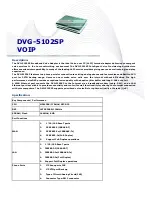
Bosch Security Systems, Inc.
Technical Manual
F.01U.193.291
Rev. 06
APPENDIX A
Basic Network Configuration
Basic Network Configuration
This section covers basic network configuration set-up and testing. Also covered are basic concepts and operations, including
the difference between LAN and WAN networks and how IP Addressing is used.
In a networked environment, such as a company, typically there are many computers connected together using a
router
or a
switch
. In larger companies, there may be several different routers distributed in buildings and plant locations. A router allows
any LAN-side computer to communicate with other computers and devices outside the LAN (local area network). Routers
send data packets from one place to another place on a network. routers use network addresses to route packets to the correct
destination. For example, in a TCP/IP network, the IP (internet protocol) address of the network interface is used to direct
router destinations.
Because routers help computers inside the LAN talk with computers outside of the LAN, the security of a company’s LAN
may be compromised by gaps of open ports in the router. Security measures may have been instituted to compensate for these
vulnerabilities. Consult you network administrator to learn about the security measures taken to protect your network.
VPN
, or
virtual private network, is one such security measure to protect the intelligence of the LAN. A computer outside the LAN must
have an address or key known by the VPN to allow access to the LAN. Many companies use a VPN to connect two different
LANs, thus allowing the transfer of data between two networks.
LAN (Local Area Network) vs. WAN (Wide Area Network)
Local Area Network
Simply put, a LAN is a computer network that connects a relatively small area (a single building or group of buildings). Most
LANs connect workstations and computers to each other. Each computer (also known as a “node”), has its own processing unit
and executes its own programs; however, it can also access data and devices anywhere on the LAN. This means many users
can access and share the same information and devices. A good example of a LAN device is a network printer. Most
companies cannot afford the budgetary or hardware expense of providing printers for each of its users; therefore, one printer
(or device) is placed on the LAN where every user can access the same printer.
The LAN uses IP Addresses to route data to different destinations on the network. An IP Address is a 32-bit numeric address
consisting of four numbers separated by periods (for example, 1.160.10.240).
NOTE:
For more information on IP Addresses, see you local network administrator.
Summary of Contents for RVON-16
Page 1: ...F 01U 193 291 Rev 06 DECEMBER 2011 RVON 16 RTS Voice Over Network...
Page 4: ...Bosch Security Systems Inc Technical Manual F 01U 193 291 Rev 06 iv RVON 16...
Page 10: ...6 Introduction RVON 16 Bosch Security Systems Inc Technical Manual F 01U 193 291 Rev 06...
Page 42: ...38 RVON 16 Bosch Security Systems Inc Technical Manual F 01U 193 291 Rev 06...
Page 49: ...RVON 16 45 Bosch Security Systems Inc Technical Manual F 01U 193 291 Rev 06 Notes...
































